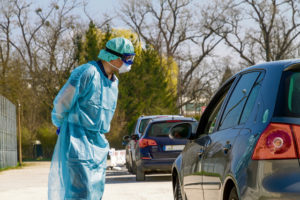 It’s been more than one year since the emergence of COVID-19, and countries around the globe have handled it in their own way.
It’s been more than one year since the emergence of COVID-19, and countries around the globe have handled it in their own way.
Airmen arriving to Germany from another assignment may find themselves wondering how their host nation country is handling the pandemic and how to stay informed about local guidelines.
Germany has taken a very methodical approach, relying on data and available resources to guide decisions. According to the Ramstein’s host nation office, Germany’s Chancellor, Angela Merkel, provides an overview of the country’s goals and regularly meets with all of the 16 state minister presidents (similar to U.S. state governors) to discuss the way ahead.
Much is decided based on an area’s seven-day incidence rate. The Rhineland-Palatinate Ministry of Health weighed in to help explain how infection rates in Germany are calculated.
“The infection rate is predominantly presented as a seven-day incidence,” said Markus Kuhlen, Ministry for Social Affairs, Labor, Health and Demography Rhineland-Palatinate deputy press officer. “It is calculated from all cases reported within one week in relation to 100,000 inhabitants.”
Officials say that a seven-day incidence of 50/100k inhabitants has been the longstanding target for multiple reasons. One is that it allows for thorough contact tracing — ensuring notification of close contacts almost to the end of infection chain. Proper contract tracing helps the health department control the spread infections. Another reason is to help protect the healthcare system to ensure there is a balance between demand and resources. Newer efforts hope to keep the regional average down to a seven-day incidence of no more than 35/100k.

When it comes to traveling throughout the country or across a border, Germany once categorized areas with more COVID-19 cases as “high risk.” The Robert Koch Institute, the authoritative public health institute in Germany, has further introduced three categories of COVID-19 infection areas. Areas can now be classified as “high-risk areas,” “high-incidence areas,” and “virus variant areas.” The different categories provide the opportunity to establish different measures for those entering the area. This distinction allows for additional and stricter regulations for regions with particularly high numbers of cases (high incidence areas) and regions where certain virus variants have spread (virus variant areas). In the latter, for example, entrants need a negative test result upon entry.
Germany successfully kept COVID-19 numbers low during the first wave because they reacted quickly to implement public health measures.
“Our goal from the very beginning was to flatten the curve of case numbers per day. The main aim was not to overburden the healthcare system throughout Germany, especially the bed capacities in the intensive care units,” said Kuhlen. “Therefore, in Germany, we called for contact avoidance and took strict measures before the first wave peaked.”
Officials say the key to success was and continues to be the willingness of the population to implement the measures in their everyday lives. One addition to help fight the second wave includes wearing medical face coverings like a surgical mask or a KN95/N95/FFP2 mask while shopping or riding public transportation.
Fortunately, there are three vaccines approved to help fight the spread of COVID-19 in Germany which have been rolling out across the country. RKI’s website includes data showing the vaccination rates across Germany’s states. The Ministry of Health is optimistic that by the end of the summer, many people in Germany should have received a vaccination.
To learn more about the latest host nation regulations and ensure you are abiding by guidelines within the Rhineland-Palatinate, visit Ramstein’s COVID-19 page at https://www.ramstein.af.mil/COVID-19/.


